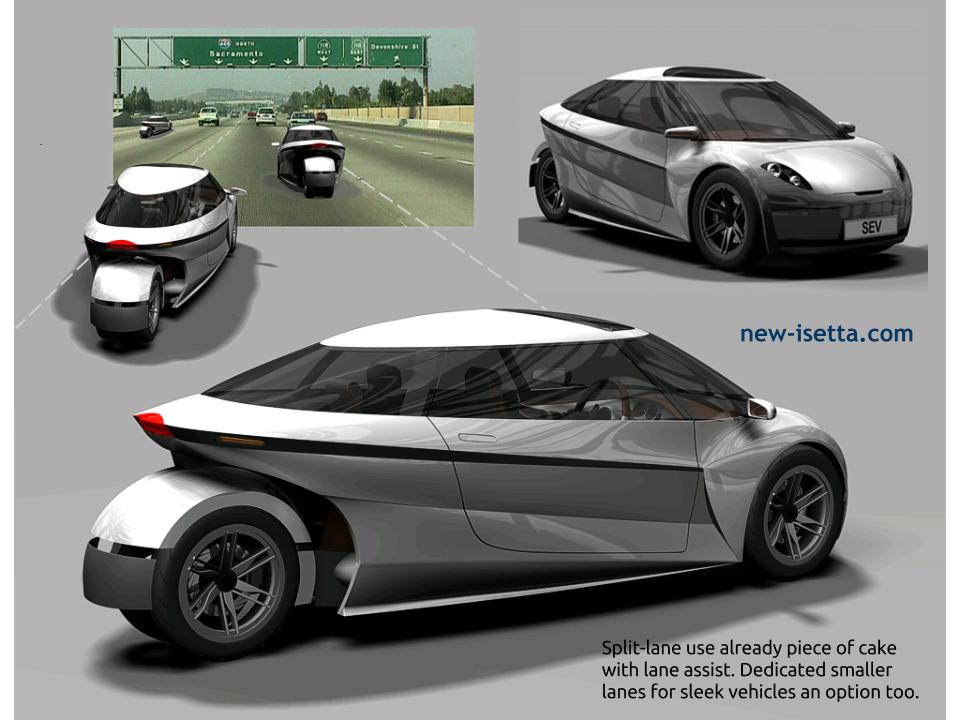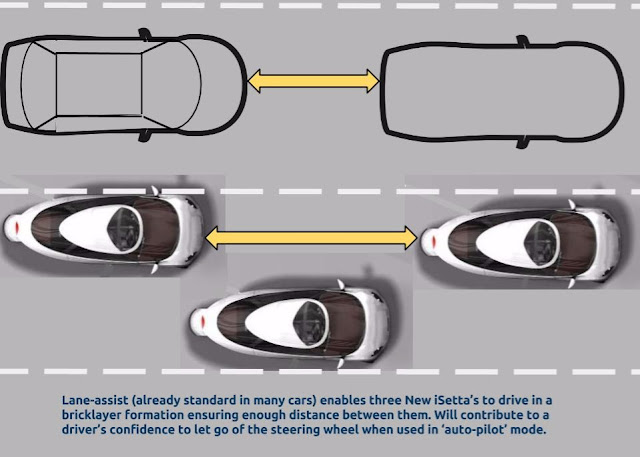Welcome to Tesla Motors Club
Discuss Tesla's Model S, Model 3, Model X, Model Y, Cybertruck, Roadster and More.
Register
Install the app
How to install the app on iOS
You can install our site as a web app on your iOS device by utilizing the Add to Home Screen feature in Safari. Please see this thread for more details on this.
Note: This feature may not be available in some browsers.
-
Want to remove ads? Register an account and login to see fewer ads, and become a Supporting Member to remove almost all ads.
You are using an out of date browser. It may not display this or other websites correctly.
You should upgrade or use an alternative browser.
You should upgrade or use an alternative browser.
"Stupid Ideas" For long range Electric Vehicle
- Thread starter Blackout
- Start date
-
- Tags
- Future Tesla
BluestarE3
Active Member
The propeller has the added benefit of letting the car be used in the water à la the Amphicar of old. Include a tidal generator in the car and when you run low on juice, drive to the nearest shore and into the ocean and let the tide generate electricity to recharge the battery!We should put a wind turbine on the front of the car and a propeller on the back of the car and we can go forever.
UniverseEnergy
New Member
Ref: "
This is why you should fill the car (bladders) with locally captured rainwater at the top of the hill, and dump the water at the bottom of the hill. This enables you to extract energy from the natural water cycle. Just use bladders that do not leak.
If the automated rock dumper used less energy than you gain from going down hill then yes, it would kind of work until you run out of rocks on top of the hill. When that happens new rocks (or the same ones) would have to be transported up to the top of the hill again. This requires energy.
This is why you should fill the car (bladders) with locally captured rainwater at the top of the hill, and dump the water at the bottom of the hill. This enables you to extract energy from the natural water cycle. Just use bladders that do not leak.
This is why you should fill the car (bladders) with locally captured rainwater at the top of the hill, and dump the water at the bottom of the hill. This enables you to extract energy from the natural water cycle. Just use bladders that do not leak.
An overshot water wheel is the most efficient mechanical device we have. If you have head (water at height), convert it to electricity with one, and charge your car with that.
Thank You Kindly.
Do both the water wheel and the bladder.
Why lower the overall efficiency like that?
Thank you kindly.
Why lower the overall efficiency like that?
Thank you kindly.
How does that lower efficiency? The water would get to some point, probably, where it has no useable head but would still flow into the bladder.
How does that lower efficiency? The water would get to some point, probably, where it has no useable head but would still flow into the bladder.
If there is no head, then there is nowhere downhill for the water to go (by definition). So, you would be putting water in a bladder in your car in order to take it UPhill. That is a 'stupid idea'.
Thank you kindly.
ratsbew
Active Member
That's a great idea for a youtube video!One "rural gentleman" who saw my Tesla suggested plugging a 110V inverter in to the 12V power socket, and then plugging my car in to that "to get extra range".
I thanked him for his insight...
BluestarE3
Active Member
I'd like to see him retry his experiment on his hybrid vehicle with an empty gas tank.You mean like this one?
How does that lower efficiency? The water would get to some point, probably, where it has no useable head but would still flow into the bladder.
Water at height has potential energy. Putting it in a bladder, thus increasing the mass of the car, at height and diving it down the mountain will give you a bit more energy into the battery, but you are putting more wear on the car from having to carry more weight and the method is very inefficient.
Instead if you let the water flow downhill through a turbine the potential energy would be turned into water head to turn the turbine and generate electricity. The turbine would have some wear from use, but the electricity generated per pound of water is much greater than the bladder idea and the wear on machinery per KW of electricity generated is much less because the turbines entire purpose is to sit in one place and generate electricity whereas the car is going to see more wear. For one thing you will be seeing wear on your tires as well as stress wear on the suspension from carrying the extra weight.
Any way you want to slice it, generating electricity from a stationary generating source and then charging up a car from it is far more efficient than any idea to charge a car through some sort of mobile device. Now regen braking is not completely efficient, but it's recapturing energy you have already expended and the alternative is to lose that energy to heat.
Diesel locomotives have used the same principle for braking since the 1950s, but in their case, they have just wasted the energy to heat with giant resistors and vents on the top of the locomotive.
Regen braking reduces your losses, but it isn't an answer for replacing charging from an external energy source.
Water at height has potential energy. Putting it in a bladder, thus increasing the mass of the car, at height and diving it down the mountain will give you a bit more energy into the battery, but you are putting more wear on the car from having to carry more weight and the method is very inefficient.
Instead if you let the water flow downhill through a turbine the potential energy would be turned into water head to turn the turbine and generate electricity. The turbine would have some wear from use, but the electricity generated per pound of water is much greater than the bladder idea and the wear on machinery per KW of electricity generated is much less because the turbines entire purpose is to sit in one place and generate electricity whereas the car is going to see more wear. For one thing you will be seeing wear on your tires as well as stress wear on the suspension from carrying the extra weight.
Any way you want to slice it, generating electricity from a stationary generating source and then charging up a car from it is far more efficient than any idea to charge a car through some sort of mobile device. Now regen braking is not completely efficient, but it's recapturing energy you have already expended and the alternative is to lose that energy to heat.
Diesel locomotives have used the same principle for braking since the 1950s, but in their case, they have just wasted the energy to heat with giant resistors and vents on the top of the locomotive.
Regen braking reduces your losses, but it isn't an answer for replacing charging from an external energy source.
I get everything you are saying and agree.
Real world, even in the "stupid ideas" thread, I imagine that you would not have the option to run the water pipe down the entire mountain, the head would be something like from your rooftop to the lowest area on your property. Next you would fill the bladder and go down the hill.
Also, if you never put the water in the bladder, you are just looking at a hydro electric system and therefore your idea would be disqualified from discussion because it is insufficiently stupid.
voyager
Active Member
Most people sit alone in their cars, especially during rush hour when commuting. What about a vehicle that is:
- low-drag and light enough to achieve a reasonable range with a substantially lighter battery pack,
- narrow enough so that you can split-lane use existing freeway lanes (in a brick-layer formation)... or even create dedicated smaller lanes (that can also be used by other NTVs and motrcyclists of course)?
There isn't a better excuse for making a vehicle truly bank (tilt) when taking long bends, than having a narrow track : long wheelbase ratio. So, Fun too.

- low-drag and light enough to achieve a reasonable range with a substantially lighter battery pack,
- narrow enough so that you can split-lane use existing freeway lanes (in a brick-layer formation)... or even create dedicated smaller lanes (that can also be used by other NTVs and motrcyclists of course)?
There isn't a better excuse for making a vehicle truly bank (tilt) when taking long bends, than having a narrow track : long wheelbase ratio. So, Fun too.

At least here in the US lane splitting is illegal in a lot of states, though legal in others.
Lit Motors is working on that concept though:
C-1 - Lit Motors
Lit Motors is working on that concept though:
C-1 - Lit Motors
voyager
Active Member

The vehicle you see can, but s not meant to drive side by side a 100%, but in a bricklayer formation.
At moderate speeds during rush hour it can make sense, although it requires more so-called NTVs to join.
But you have to start at some point.
The Lit Motors C1 is meant to drive side by side, like any motorcyclist can.
Similar threads
- Replies
- 1
- Views
- 179
- Replies
- 35
- Views
- 4K
- Replies
- 48
- Views
- 3K
- Replies
- 85
- Views
- 4K


